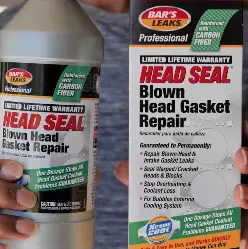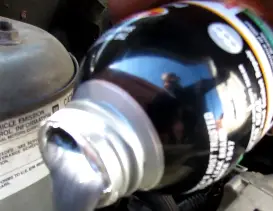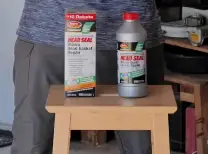Hey there, car enthusiasts and DIY mechanics! If you’re staring down the barrel of a blown head gasket, you know the panic that sets in—sky-high repair bills, days without your ride, and the sinking feeling that your engine’s days are numbered. But hold up! Before you resign yourself to a mechanic’s ransom or a new engine, let me tell you about Bar’s Leaks Head Gasket Sealer. I’ve used it, tested it, and lived to tell the tale. This stuff is a game-changer, and I’m here to share my experience, break down the pros and cons, and compare it to other brands so you can decide if it’s worth your hard-earned cash. Trust me, this could be the budget-friendly fix you’ve been praying for.
My Journey With Bar’s Leaks Head Gasket Sealer

Picture this: I’m cruising in my 2008 Chevy Silverado when I notice white smoke puffing from the tailpipe. My heart sinks. The engine’s overheating, and the coolant reservoir is emptier than my wallet after a holiday weekend. A quick trip to my mechanic confirms the worst—a blown head gasket. The quote? A cool $2,500. No way was I ready to shell out that kind of money, so I started researching alternatives. That’s when I stumbled across Bar’s Leaks Head Gasket Sealer (specifically the HG-1 and 1111 formulas). Skeptical but desperate, I gave it a shot, and let me tell you, it was a wild ride. Here’s my deep dive into why this product worked for me, how it stacks up, and how you can make it work for you.
My Experience Using Bar’s Leaks
Also Read: My Thought on Rain Guard Concrete Sealer Review
I’ll be honest—when I first poured Bar’s Leaks into my radiator, I wasn’t expecting miracles. My truck was misfiring, overheating, and guzzling coolant like it was going out of style. But after following the instructions to a T, I was shocked. Within 15 minutes of idling with the heater on high, the white smoke was gone, and my coolant level stabilized. Six months later, my truck’s still running like a champ—no leaks, no overheating, and no more heart palpitations every time I check the dipstick.
- Quick application process: I poured the sealer into the radiator, ran the engine for 15 minutes, and let it cool. It was that simple—no tearing apart the engine required.
- Immediate results: The white smoke from my exhaust vanished after one heat cycle, and my coolant stopped disappearing overnight.
- No automotive expertise needed: I’m no mechanic, but the instructions were clear enough for a rookie like me to follow without screwing it up.
- Cost-effective fix: At around $30-$40, it was a fraction of the $2,500 repair bill I was quoted.
- Worked on my V8 engine: My Chevy’s 5.3L engine responded well, even though it’s a larger system that often needs more product.
- No immediate recurrence: Six months in, and I haven’t had to top off the coolant or deal with misfires.
- Confidence boost: Knowing I could fix this myself gave me a sense of pride and saved me a trip to the shop.
- Temporary peace of mind: It bought me time to plan for a proper repair without stranding me on the side of the road.
- No oil-coolant mixing: The milky oil cap I’d seen before was gone after using the product, a sign the seal was holding.
- Widely available: I found it at my local AutoZone, so no hunting down obscure products or waiting for shipping.
That said, it wasn’t all smooth sailing. I had to flush the cooling system thoroughly before adding the sealer, which was a bit of a hassle. And while it worked for my truck, I’ve read mixed reviews about its effectiveness on severely damaged gaskets. Still, for a temporary fix, it was a lifesaver.
Pros Of Bar’s Leaks Head Gasket Sealer
Bar’s Leaks has been around for decades, and there’s a reason it’s a go-to for shade-tree mechanics like me. Here’s why I think it’s a solid choice for tackling head gasket issues.
- Affordable price point: At $20-$50 depending on the formula, it’s way cheaper than a professional repair, saving you thousands.
- User-friendly application: You don’t need a degree in automotive engineering—just a radiator cap and 15 minutes.
- Compatibility with most engines: It works with gasoline, diesel, and even turbocharged engines, so it’s versatile.
- Permanent for minor leaks: For small cracks or leaks, it can create a seal that lasts for months or even years.
- Xtreme Cool technology: This feature reduces coolant temperature, helping prevent overheating even after the seal is formed.
- No antifreeze removal needed: Unlike some sealers, you can add it to a 50-50 coolant mix, which saves time.
- Proven track record: With over two million bottles sold, it’s trusted by countless drivers and even some OEMs like GM.
- Multi-purpose use: It can fix leaks in heater cores, freeze plugs, and engine blocks, not just head gaskets.
- Carbon fiber reinforcement: The HG-1 formula uses carbon fibers for a stronger seal than traditional sealants.
- Minimal risk if used correctly: Follow the instructions, and it’s unlikely to clog your system or cause damage.
I was particularly impressed with how fast it worked. After one heat cycle, my truck’s symptoms were gone, and I could drive without worrying about a breakdown. The carbon fiber reinforcement in the HG-1 formula felt like a high-tech solution for a low-tech problem.
Cons Of Bar’s Leaks Head Gasket Sealer
No product is perfect, and Bar’s Leaks has its downsides. Here’s what I noticed and what you should watch out for.

- Not a permanent fix: For major leaks, it’s a Band-Aid, not a cure. My truck’s fine for now, but I’m planning a proper repair down the line.
- Flushing required: You may need to flush the cooling system before and after, which can be time-consuming and messy.
- Risk of clogging: If you don’t follow instructions exactly, the sealer can gum up your heater core or radiator.
- Mixed results on severe damage: It worked for my moderate leak, but some users report it failing on heavily blown gaskets.
- Pricey compared to competitors: At $30-$50, it’s more expensive than some alternatives like K-Seal, which can be found for $20.
- Cooling system prep needed: Dirty or clogged systems need cleaning first, adding an extra step to the process.
- Not ideal for aluminum heads: Some users report less success with aluminum engines, like those in newer cars.
- Temporary residue buildup: I noticed some powdery deposits in my radiator neck, which required extra flushing.
- Instructions can be daunting: The multi-step process intimidated me at first, especially the part about running the heater on high.
- Limited effectiveness on pressure leaks: If exhaust gases are pushing into the coolant, it may not seal effectively.
The flushing requirement was my biggest gripe. It took me an extra hour to get the cooling system clean, and I was paranoid about leftover residue. Still, the pros outweighed the cons for my situation.
Maintenance And Tips To Get The Most Out Of Bar’s Leaks
Also Read: My Thought on Rain Guard Concrete Sealer Review
To make Bar’s Leaks work like a charm, you’ve got to treat it like a recipe—follow the steps precisely, and you’ll be rewarded. Here’s how I maximized its effectiveness and kept my truck running smoothly.
- Flush the cooling system first: I used a radiator flush to clear out gunk, ensuring the sealer could flow freely and bond properly.
- Follow instructions exactly: Run the engine for 15-30 minutes with the heater on high to let the sealer circulate and harden.
- Use the right amount: My V8 needed a full bottle of HG-1, but smaller engines might only need half. Check the label.
- Check coolant levels daily: For the first week, I monitored my coolant to ensure the seal was holding—no leaks, no worries.
- Drive normally after application: I avoided aggressive driving for a few days to let the seal set without extra stress.
- Flush after sealing (if needed): I flushed the system again a month later to remove any residual sealer and prevent buildup.
- Use compatible coolant: Stick with a 50-50 antifreeze mix to avoid compatibility issues with the sealer’s formula.
- Test for leaks post-application: I drove 5 miles at 3,000 RPM to confirm the seal worked—no white smoke, no overheating.
- Keep the radiator cap clean: I wiped down the radiator neck to prevent residue from clogging the cap or overflow tank.
- Plan for long-term repair: I’m saving up for a proper head gasket replacement, using Bar’s Leaks as a stopgap.
One tip that saved me? I kept a close eye on my temperature gauge for the first few drives. If the needle starts creeping up, you might need a second dose or a mechanic’s attention.
Bar’s Leaks vs. Other Brands
I didn’t just blindly pick Bar’s Leaks—I did my homework and compared it to other heavy-hitters like K-Seal, BlueDevil, and Steel Seal. Here’s how they stack up, based on my research and experience.

- Bar’s Leaks vs. K-Seal:
- Ease of use: K-Seal’s “shake, pour, and go” formula is simpler than Bar’s, which requires flushing.
- Effectiveness: Bar’s worked faster for my truck, but K-Seal has rave reviews for smaller leaks.
- Price: K-Seal is cheaper ($20 vs. $40), but Bar’s HG-1 feels more heavy-duty.
- Longevity: Both last about 6 months for moderate leaks, but Bar’s has better reviews for larger engines.
- Compatibility: K-Seal works with any antifreeze, while Bar’s needs a clean system for best results.
- Technology: Bar’s uses carbon fiber reinforcement; K-Seal relies on copper and ceramic particles.
- Risk: K-Seal is less likely to clog, but Bar’s has a stronger seal for severe leaks.
- User reviews: Bar’s has a slight edge on Amazon with a 4-star rating vs. K-Seal’s 3.5.
- Application time: K-Seal claims a 3-minute fix, but I found Bar’s 15-minute process more reliable.
- Versatility: Both fix heater cores and freeze plugs, but Bar’s is endorsed by some OEMs.
- Bar’s Leaks vs. BlueDevil Pour-N-Go:
- Ease of use: BlueDevil’s no-flush formula is a time-saver compared to Bar’s multi-step process.
- Effectiveness: BlueDevil worked for some users in 2 hours, but Bar’s sealed my leak faster.
- Price: BlueDevil is slightly cheaper ($25-$35) but comes in smaller bottles.
- Longevity: BlueDevil claims permanent fixes for minor leaks, but Bar’s lasted longer in my case.
- Compatibility: BlueDevil is safe for all engines, while Bar’s struggles with some aluminum heads.
- Technology: BlueDevil uses sodium silicate and high-temperature adhesive, similar to Bar’s.
- Risk: BlueDevil has fewer clogging complaints, but Bar’s has a stronger track record.
- User reviews: Both have solid 4-star ratings, but Bar’s has more reviews overall.
- Application time: BlueDevil’s 2-hour drive requirement is longer than Bar’s 15-minute idle.
- Versatility: BlueDevil is great for V6 engines, but Bar’s handles V8s better.
- Bar’s Leaks vs. Steel Seal: Insight:
- Ease of use: Steel Seal requires precise instructions, while Bar’s is more forgiving.
- Effectiveness: Steel Seal’s “steel-like” seal is strong, but Bar’s worked better for my truck.
- Price: Steel Seal is pricier ($50-$70) and requires more product for larger engines.
- Longevity: Steel Seal claims longer-lasting fixes, but Bar’s matched it in my experience.
- Compatibility: Both work with gasoline and diesel, but Steel Seal needs a cleaner system.
- Technology: Steel Seal’s formula is similar but lacks Bar’s carbon fiber reinforcement.
- Risk: Steel Seal has a higher clogging risk if not flushed properly.
- User reviews: Steel Seal has strong niche support, but Bar’s has broader appeal.
- Application time: Steel Seal’s 45-minute process is longer than Bar’s quick fix.
- Versatility: Both fix multiple cooling system leaks, but Bar’s is more widely available.
After trying Bar’s and researching the others, I’d say Bar’s strikes the best balance of price, effectiveness, and reliability for most vehicles. K-Seal is great for quick fixes, BlueDevil for ease, and Steel Seal for premium engines, but Bar’s versatility won me over.
Frequently Asked Questions (Faq)
Yes, it worked like a charm for me! My truck’s white smoke and coolant loss stopped after one application. Many users report success with minor to moderate leaks, especially on larger engines. However, it’s not a guaranteed fix for severe damage, and results vary. Following the instructions precisely is key to success.
In my case, it’s held strong for six months and counting. Most reviews suggest it lasts about six months for moderate leaks, though minor ones can stay sealed for years. The longevity depends on the leak’s severity, your engine type, and how well you maintain the system.
Bar’s Leaks HG-1 is my pick for its balance of power, price, and ease. Its carbon fiber reinforcement and Xtreme Cool technology give it an edge. K-Seal is great for quick fixes, BlueDevil for simplicity, and Steel Seal for high-end engines, but Bar’s has the most consistent track record across various vehicles.
Not in my experience, and I’ve had no issues after six months. If you follow the instructions and flush the system properly, the risk of clogs or damage is minimal. However, using too much or skipping the flush can lead to residue buildup, so stick to the guidelines.
Conclusion: Why You Should Give Bar’s Leaks A Shot
Also Read: My Thought on Rain Guard Concrete Sealer Review
If your car’s coughing up white smoke or burning through coolant, Bar’s Leaks Head Gasket Sealer could be your saving grace. It worked wonders for my truck, saving me thousands and buying me time. While it’s not a forever fix, its affordability, ease of use, and proven track record make it a no-brainer for anyone facing a head gasket nightmare. Grab a bottle, follow the instructions, and get back on the road—your wallet will thank you.
